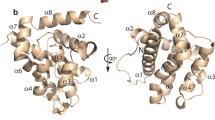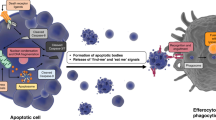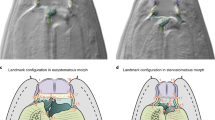Abstract
Studies of the nematode worm Caenorhabditis elegans have provided important insights into the genetics of programmed cell death (PCD), and revealed molecular mechanisms conserved from nematodes to humans. The organism continues to offer opportunities to investigate the processes of apoptosis under very well-defined conditions and at single-cell resolution in living animals. Here, a survey of the common methods used to study the process of PCD in C. elegans is described. Detailed instructions are provided for one standard method—the counting of extra cells of the anterior pharynx—a quantitative technique that can be used to detect even very subtle alterations in the progression of apoptotic cell death.
This is a preview of subscription content, access via your institution
Access options
Subscribe to this journal
Receive 12 print issues and online access
$259.00 per year
only $21.58 per issue
Buy this article
- Purchase on Springer Link
- Instant access to full article PDF
Prices may be subject to local taxes which are calculated during checkout








Similar content being viewed by others
References
Jacobson, M.D., Weil, M. & Raff, M.C. Programmed cell death in animal development. Cell 88, 347–354 (1997).
Benn, S.C. & Woolf, C.J. Adult neuron survival strategies—slamming on the brakes. Nat. Rev. Neurosci. 5, 686–700 (2004).
Bidere, N., Su, H.C. & Lenardo, M.J. Genetic disorders of programmed cell death in the immune system. Annu. Rev. Immunol. 24, 321–352 (2006).
Fesik, S.W. Promoting apoptosis as a strategy for cancer drug discovery. Nat. Rev. Cancer 5, 876–885 (2005).
Ellis, H.M. & Horvitz, H.R. Genetic control of programmed cell death in the nematode C. elegans . Cell 44, 817–829 (1986).
Horvitz, H.R. Worms, life, and death (Nobel lecture). ChemBioChem 4, 697–711 (2003).
Yuan, J. & Horvitz, H.R. A first insight into the molecular mechanisms of apoptosis. Cell 116, S53–S56 1 p following S59 (2004).
Lettre, G. & Hengartner, M.O. Developmental apoptosis in C. elegans: a complex CEDnario. Nat. Rev. Mol. Cell Biol. 7, 97–108 (2006).
Metzstein, M.M., Stanfield, G.M. & Horvitz, H.R. Genetics of programmed cell death in C. elegans: past, present and future. Trends Genet. 14, 410–416 (1998).
Yuan, J., Shaham, S., Ledoux, S., Ellis, H.M. & Horvitz, H.R. The C. elegans cell death gene ced-3 encodes a protein similar to mammalian interleukin-1 beta-converting enzyme. Cell 75, 641–852 (1993).
Yuan, J. & Horvitz, H.R. The Caenorhabditis elegans cell death gene ced-4 encodes a novel protein and is expressed during the period of extensive programmed cell death. Development 116, 309–320 (1992).
Zou, H., Henzel, W.J., Liu, X., Lutschg, A. & Wang, X. Apaf-1, a human protein homologous to C. elegans CED-4, participates in cytochrome c-dependent activation of caspase-3. Cell 90, 405–413 (1997).
Hengartner, M.O., Ellis, R.E. & Horvitz, H.R. Caenorhabditis elegans gene ced-9 protects cells from programmed cell death. Nature 356, 494–499 (1992).
Hengartner, M.O. & Horvitz, H.R. C. elegans cell survival gene ced-9 encodes a functional homolog of the mammalian proto-oncogene bcl-2 . Cell 76, 665–676 (1994).
Shaham, S. & Horvitz, H.R. Developing Caenorhabditis elegans neurons may contain both cell-death protective and killer activities. Genes Dev. 10, 578–591 (1996).
Conradt, B. & Horvitz, H.R. The C. elegans protein EGL-1 is required for programmed cell death and interacts with the Bcl-2-like protein CED-9. Cell 93, 519–529 (1998).
Conradt, B. & Horvitz, H.R. The TRA-1A sex determination protein of C. elegans regulates sexually dimorphic cell deaths by repressing the egl-1 cell death activator gene. Cell 98, 317–327 (1999).
Sulston, J.E. & Horvitz, H.R. Post-embryonic cell lineages of the nematode, Caenorhabditis elegans . Dev. Biol. 56, 110–156 (1977).
Sulston, J.E., Schierenberg, E., White, J.G. & Thomson, J.N. The embryonic cell lineage of the nematode Caenorhabditis elegans . Dev. Biol. 100, 64–119 (1983).
Ledwich, D., Wu, Y.C., Driscoll, M. & Xue, D. Analysis of programmed cell death in the nematode Caenorhabditis elegans . Methods Enzymol. 322, 76–88 (2000).
Shaham, S. ed. WormBook: Methods in Cell Biology (January 2, 2006), WormBook, ed. The C. elegans Research Community, WormBook, doi/10.1895/wormbook.1.49.1, http://www.wormbook.org.
Liu, H., Strauss, T.J., Potts, M.B. & Cameron, S. Direct regulation of egl-1 and of programmed cell death by the Hox protein MAB-5 and by CEH-20, a C. elegans homolog of Pbx1. Development 133, 641–650 (2006).
Thellmann, M., Hatzold, J. & Conradt, B. The Snail-like CES-1 protein of C. elegans can block the expression of the BH3-only cell-death activator gene egl-1 by antagonizing the function of bHLH proteins. Development 130, 4057–4071 (2003).
Jagasia, R., Grote, P., Westermann, B. & Conradt, B. DRP-1-mediated mitochondrial fragmentation during EGL-1-induced cell death in C. elegans . Nature 433, 754–760 (2005).
Reddien, P.W., Cameron, S. & Horvitz, H.R. Phagocytosis promotes programmed cell death in C. elegans . Nature 412, 198–202 (2001).
Hodgkin, J. Exploring the envelope. Systematic alteration in the sex-determination system of the nematode Caenorhabditis elegans . Genetics 162, 767–780 (2002).
Hoeppner, D.J. et al. eor-1 and eor-2 are required for cell-specific apoptotic death in C. elegans . Dev. Biol. 274, 125–138 (2004).
Yang, C. et al. RNA aptamers targeting the cell death inhibitor CED-9 induce cell killing in Caenorhabditis elegans . J. Biol. Chem. 281, 9137–9144 (2006).
Faber, P.W., Voisine, C., King, D.C., Bates, E.A. & Hart, A.C. Glutamine/proline-rich PQE-1 proteins protect Caenorhabditis elegans neurons from huntingtin polyglutamine neurotoxicity. Proc. Natl. Acad. Sci. USA 99, 17131–17136 (2002).
Faber, P.W., Alter, J.R., MacDonald, M.E. & Hart, A.C. Polyglutamine-mediated dysfunction and apoptotic death of a Caenorhabditis elegans sensory neuron. Proc. Natl. Acad. Sci. USA 96, 179–184 (1999).
Zhou, Z., Hartwieg, E. & Horvitz, H.R. CED-1 is a transmembrane receptor that mediates cell corpse engulfment in C. elegans . Cell 104, 43–56 (2001).
Schumacher, B. et al. C. elegans ced-13 can promote apoptosis and is induced in response to DNA damage. Cell Death Differ. 12, 153–161 (2005).
Kinchen, J.M. et al. Two pathways converge at CED-10 to mediate actin rearrangement and corpse removal in C. elegans . Nature 434, 93–99 (2005).
Yu, X., Odera, S., Chuang, C.H., Lu, N. & Zhou, Z. C. elegans dynamin mediates the signaling of phagocytic receptor CED-1 for the engulfment and degradation of apoptotic cells. Dev. Cell 10, 743–757 (2006).
Shaham, S., Reddien, P.W., Davies, B. & Horvitz, H.R. Mutational analysis of the Caenorhabditis elegans cell-death gene ced-3 . Genetics 153, 1655–1671 (1999).
Stanfield, G.M. & Horvitz, H.R. The ced-8 gene controls the timing of programmed cell deaths in C. elegans . Mol. Cell 5, 423–433 (2000).
Speliotes,, E.K. C. elegans BIR-1 acts with the Aurora-like kinase AIR-2 to affect chromosomes and the spindle midzone. PhD Thesis, Massachusetts Institute of Technology, Cambridge, Massachusetts, (2000).
Robertson, A.M.G. & Thompson, J.N. Ultrastructural study of cell death in Caenorhabditis elegans . J. Embryol. Exp. Morphol. 67, 89–100 (1982).
Ellis, R.E., Jacobson, D.M. & Horvitz, H.R. Genes required for the engulfment of cell corpses during programmed cell death in Caenorhabditis elegans . Genetics 129, 79–94 (1991).
Zhou, Z., Caron, E., Hartwieg, E., Hall, A. & Horvitz, H.R. The C. elegans PH domain protein CED-12 regulates cytoskeletal reorganization via a Rho/Rac GTPase signaling pathway. Dev. Cell 1, 477–489 (2001).
Hedgecock, E.M., Sulston, J.E. & Thomson, J.N. Mutations affecting programmed cell deaths in the nematode Caenorhabditis elegans . Science 220, 1277–1279 (1983).
Fixsen, W. The genetic control of hypodermal lineages during nematode development. PhD Thesis, Massachusetts Institute of Technology, Cambridge, Massachusetts, (1985).
Sulston, J.E. Post-embryonic development in the ventral cord of Caenorhabditis elegans . Philos. Trans. R. Soc. London B 275, 287–297 (1976).
Wu, Y.C., Stanfield, G.M. & Horvitz, H.R. NUC-1, a Caenorhabditis elegans DNase II homolog, functions in an intermediate step of DNA degradation during apoptosis. Genes Dev. 14, 536–548 (2000).
Gumienny, T.L., Lambie, E., Hartwieg, E., Horvitz, H.R. & Hengartner, M.O. Genetic control of programmed cell death in the Caenorhabditis elegans hermaphrodite germline. Development 126, 1011–1022 (1999).
Gavrieli, Y., Sherman, Y. & Ben-Sasson, S.A. Identification of programmed cell death in situ via specific labeling of nuclear DNA fragmentation. J. Cell Biol. 119, 493–501 (1992).
Parrish, J. et al. Mitochondrial endonuclease G is important for apoptosis in C. elegans . Nature 412, 90–94 (2001).
Wang, X., Yang, C., Chai, J., Shi, Y. & Xue, D. Mechanisms of AIF-mediated apoptotic DNA degradation in Caenorhabditis elegans . Science 298, 1587–1592 (2002).
Parrish, J.Z., Yang, C., Shen, B. & Xue, D. CRN-1, a Caenorhabditis elegans FEN-1 homologue, cooperates with CPS-6/EndoG to promote apoptotic DNA degradation. EMBO J. 22, 3451–3460 (2003).
Parrish, J.Z. & Xue, D. Functional genomic analysis of apoptotic DNA degradation in C. elegans . Mol. Cell 11, 987–996 (2003).
Eisenhut, R.J., Knox, D. & Hermann, G.J. Characterization of a conserved apoptotic marker expressed in Caenorhabditis elegans phagocytic cells. Biochem. Biophys. Res. Commun. 335, 1231–1238 (2005).
Green, D.R. & Kroemer, G. The pathophysiology of mitochondrial cell death. Science 305, 626–629 (2004).
Chen, F. et al. Translocation of C. elegans CED-4 to nuclear membranes during programmed cell death. Science 287, 1485–1489 (2000).
Delivani, P., C., A., Taylor, R.C., Duriez, P.J. & Martin, S.J. Role for CED-9 and EGL-1 as regulators of mitochondrial fission and fusion dynamics. Mol. Cell 21, 761–773 (2006).
Wu, Y.C. & Horvitz, H.R. The C. elegans cell corpse engulfment gene ced-7 encodes a protein similar to ABC transporters. Cell 93, 951–960 (1998).
Wu, Y.C. & Horvitz, H.R. C. elegans phagocytosis and cell-migration protein CED-5 is similar to human DOCK180. Nature 392, 501–504 (1998).
Sugimoto, A. et al. Many genomic regions are required for normal embryonic programmed cell death in Caenorhabditis elegans . Genetics 158, 237–252 (2001).
Thomas, C., DeVries, P., Hardin, J. & White, J. Four-dimensional imaging: computer visualization of 3D movements in living specimens. Science 273, 603–607 (1996).
Barr, M.M. & Sternberg, P.W. A polycystic kidney-disease gene homologue required for male mating behaviour in C elegans . Nature 401, 386–389 (1999).
Hengartner, M.O. & Horvitz, H.R. Activation of C. elegans cell death protein CED-9 by an amino-acid substitution in a domain conserved in Bcl-2. Nature 369, 318–320 (1994).
Brenner, S. The genetics of Caenorhabditis elegans . Genetics 77, 71–94 (1974).
Herman, T., Hartwieg, E. & Horvitz, H.R. sqv mutants of Caenorhabditis elegans are defective in vulval epithelial invagination. Proc. Natl. Acad. Sci. USA 96, 968–973 (1999).
Aspock, G., Ruvkun, G. & Burglin, T.R. The Caenorhabditis elegans ems class homeobox gene ceh-2 is required for M3 pharynx motoneuron function. Development 130, 3369–3378 (2003).
Sze, J.Y., Victor, M., Loer, C., Shi, Y. & Ruvkun, G. Food and metabolic signalling defects in a Caenorhabditis elegans serotonin-synthesis mutant. Nature 403, 560–564 (2000).
Lints, R. & Emmons, S.W. Patterning of dopaminergic neurotransmitter identity among Caenorhabditis elegans ray sensory neurons by a TGFbeta family signaling pathway and a Hox gene. Development 126, 5819–5831 (1999).
Alkema, M.J., Hunter-Ensor, M., Ringstad, N. & Horvitz, H.R. Tyramine functions independently of octopamine in the Caenorhabditis elegans nervous system. Neuron 46, 247–260 (2005).
Burdine, R.D., Branda, C.S. & Stern, M.J. EGL-17(FGF) expression coordinates the attraction of the migrating sex myoblasts with vulval induction in C. elegans . Development 125, 1083–1093 (1998).
Desai, C., Garriga, G., McIntire, S.L. & Horvitz, H.R. A genetic pathway for the development of the Caenorhabditis elegans HSN motor neurons. Nature 336, 638–646 (1988).
Desai, C. & Horvitz, H.R. Caenorhabditis elegans mutants defective in the functioning of the motor neurons responsible for egg laying. Genetics 121, 703–721 (1989).
Shaham, S. & Horvitz, H.R. An alternatively spliced C. elegans ced-4 RNA encodes a novel cell death inhibitor. Cell 86, 201–208 (1996).
Driscoll, M. & Chalfie, M. The mec-4 gene is a member of a family of Caenorhabditis elegans genes that can mutate to induce neuronal degeneration. Nature 349, 588–593 (1991).
Ferguson, E.L. & Horvitz, H.R. Identification and characterization of 22 genes that affect the vulval cell lineages of the nematode Caenorhabditis elegans . Genetics 110, 17–72 (1985).
Joshi, P. & Eisenmann, D.M. The Caenorhabditis elegans pvl-5 gene protects hypodermal cells from ced-3-dependent, ced-4-independent cell death. Genetics 167, 673–685 (2004).
Acknowledgements
I thank H. Robert Horvitz, Brendan Galvin and Daniel Denning for their comments on the manuscript, Brian Harfe and Andrew Fire for providing the unpublished egl-17∷gfp reporter and information on its expression in the M4 neuron, Brendan Galvin for discussions regarding the use of lin-11∷gfp, Maureen Barr and Paul Sternberg for pkd-2∷gfp, Robyn Lints and Scott Emmons for cat-2∷gfp, Catherine Branda and Michael Stern for egl-17∷gfp and Mike Hurwitz for the ced-1(e1735); bcIs39 strain. This work was supported by a David H. Koch Graduate Fellowship and by funding from the Howard Hughes Medical Institute to H. Robert Horvitz.
Author information
Authors and Affiliations
Corresponding author
Ethics declarations
Competing interests
The author declares no competing financial interests.
Rights and permissions
About this article
Cite this article
Schwartz, H. A protocol describing pharynx counts and a review of other assays of apoptotic cell death in the nematode worm Caenorhabditis elegans. Nat Protoc 2, 705–714 (2007). https://doi.org/10.1038/nprot.2007.93
Published:
Issue Date:
DOI: https://doi.org/10.1038/nprot.2007.93
This article is cited by
-
The cisd gene family regulates physiological germline apoptosis through ced-13 and the canonical cell death pathway in Caenorhabditis elegans
Cell Death & Differentiation (2019)
-
Somatically expressed germ-granule components, PGL-1 and PGL-3, repress programmed cell death in C. elegans
Scientific Reports (2016)
-
Development of a transformation system for Hirsutella spp. and visualization of the mode of nematode infection by GFP-labeled H. minnesotensis
Scientific Reports (2015)
-
Small GTPase CDC-42 promotes apoptotic cell corpse clearance in response to PAT-2 and CED-1 in C. elegans
Cell Death & Differentiation (2014)
-
PDR-1/hParkin negatively regulates the phagocytosis of apoptotic cell corpses in Caenorhabditis elegans
Cell Death & Disease (2014)
Comments
By submitting a comment you agree to abide by our Terms and Community Guidelines. If you find something abusive or that does not comply with our terms or guidelines please flag it as inappropriate.



